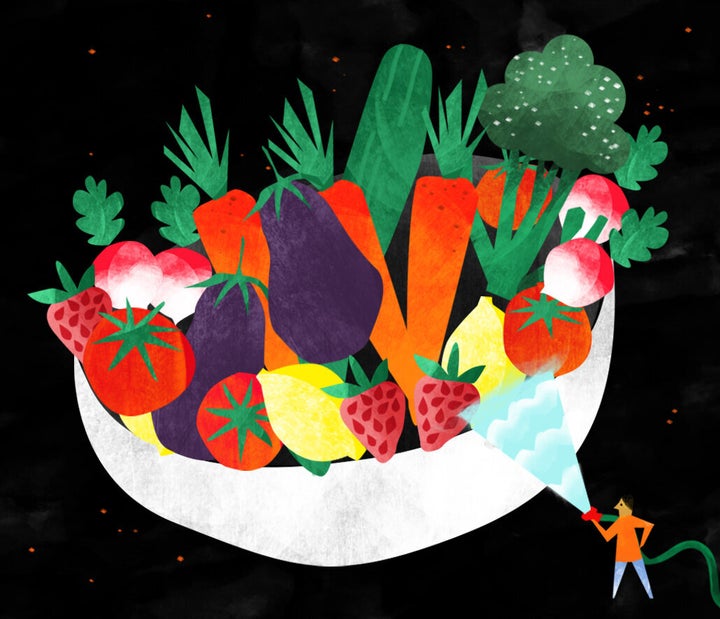
The conversations around exactly how to wash your produce are contentious. There are camps that think a rinse in water is enough, while others think the only way to truly clean the dirt, wax and chemicals off your fruits and vegetables is with a store-bought produce wash, soapy taste be damned.
The jury may still be out on that one, but one thing is clear: We need to rinse our fruits and vegetables with water (and give them a good scrub). However, it’s not always clear how important it is, or how to do it properly. That’s why we asked the experts. Here’s everything you need to know about washing your fruits and vegetables.
Why do you need to wash your fruits and veggies in the first place?
There are a few reasons it’s important to rinse every fruit and vegetable you consume with water. First, there’s often dirt on them before they’re washed, and no one likes eating dirt. And more pressing, many fruits and vegetables are sprayed with pesticides, which aren’t necessarily safe for consumption.
But according to nutritionist Karina Heinrich, the most important reason for rinsing and scrubbing fruits and vegetables is to protect yourself from foodborne illnesses. In fact, according to the Food and Drug Administration, 48 million people get sick from contaminated food each year.
“The goal with washing well is to decrease bacteria and prevent any illness, such as E. Coli,” she said.
FDA attorney Marc Sanchez added that we only hear about some of the foodborne illnesses that occur, such as salmonella or E. Coli ― so people getting sick from unwashed fruits and vegetables is actually more common than we think. “Often we only hear about the big outbreaks, but contamination can occur on any scale,” he explained.
Heinrich also noted that timing matters a lot more than most people think ― both to avoid getting sick and because your produce will last longer. “The best time to wash produce is immediately before eating or cooking the product,” she said. “You should avoid rinsing and then storing produce because it creates a perfect, wet habitat for bacteria to grow. Too much moisture can cause fruits and vegetables to go bad more quickly.”
Here’s how to wash your fruits and vegetables.
Here’s the big question: Can you get away with running water over your fruits and vegetables and call it a day? Sanchez says yes; Heinrich says no.
“Start by properly washing your hands with soap or water, which ensures that no microbes are transferred from your hands to the fresh produce,” Sanchez said. “When actually washing, use running water and rub fruits and vegetables briskly with your hands to remove dirt and surface microorganisms. For something with a hard rind or firm skin, a vegetable brush can be used to scrub the surface. A good tip is to avoid using hot water, which can allow microorganisms to enter the stem or blossom end of the produce.”

Sanchez advises against using any kind of produce wash, since the effects of ingesting them haven’t been properly studied. While Heinrich doesn’t suggest buying produce wash ― it can lead to a new set of residue ― she does recommend taking your washing a step beyond water.
“Rinsing fruit under the kitchen tap may remove dirt,” she said. “But lots of research shows that adding baking soda to the water is the best way to remove pesticide residue. To take bacteria elimination a step further, use a vegetable brush when washing produce with thick skin and throw away the outer leaves of leafy green vegetables such as cabbage and lettuce before washing.”
To make a DIY vegetable wash, Heinrich recommends filling your (clean) kitchen sink with cold water and adding 4 tablespoons of baking soda.
“Soak fruits and vegetables for about five minutes, rinse with cold water and pat dry,” she said. “Exceptions to using this wash are berries or other soft fruits and vegetables that may get too soggy. They still need to be cleaned, but make sure to rinse in the baking soda solution quickly.”
Should some vegetables and fruits be washed more than others?
While none of your fruits or veggies should be consumed before washing, this can get confusing ― especially when your lettuce package says it’s been “triple washed.” “This is not a regulated claim and not one validated or verified by the FDA, which is why I always recommend washing again anyway,” said Sanchez. “Better safe than sorry, as the adage goes.”
And while you’re at it, Heinrich recommends paying special attention to the “dirty dozen.” “This list is made by the Environmental Working Group and ranks fruits and vegetables from most to least likely to have pesticide residue,” she said. “The Dirty Dozen list for 2019 are strawberries, spinach, kale, nectarines, apples, grapes, peaches, cherries, pears, tomatoes, celery and potatoes. More than 90 percent of samples of strawberries, apples, cherries, spinach, nectarines, and kale tested positive for residues of two or more pesticides. Multiple samples of kale showed 18 different pesticides.”
In other words, pay special attention when washing any member of the dirty dozen.
Here’s what the government recommends.
Yep, that’s a lot of information about how to wash your fruits and vegetables ― and we don’t blame you if you’re feeling just a little nervous about foodborne illnesses by now. Before you start whipping up that baking soda solution, rest assured that the government recommendations around washing produce are pretty simple:
Wash your hands with soap and water, rinse produce before you peel, and give it a gentle rub while holding it under running water. Got tougher produce? Go ahead and use a vegetable brush.
And fire up that grill — you’ve got some summer veggies to cook.